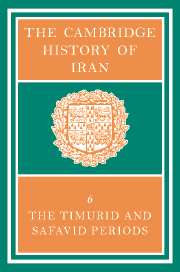Book contents
- Frontmatter
- 1 THE JALAYIRIDS, MUZAFFARIDS AND SARBADĀRS
- 2 TĪMŪR IN IRAN
- 3 THE SUCCESSORS OF TĪMŪR
- 4 THE TÜRKMEN DYNASTIES
- 5 THE SAFAVID PERIOD
- 6 THE SAFAVID ADMINISTRATIVE SYSTEM
- 7 EUROPEAN CONTACTS WITH PERSIA, 1350–1736
- 8 TRADE FROM THE MID-14TH CENTURY TO THE END OF THE SAFAVID PERIOD
- 9 SOCIAL AND INTERNAL ECONOMIC AFFAIRS
- 10 THE EXACT SCIENCES IN TIMURID IRAN
- 11 PERSIAN SCIENCE IN SAFAVID TIMES
- 12 RELIGION IN THE TIMURID AND SAFAVID PERIODS
- 13 SPIRITUAL MOVEMENTS, PHILOSOPHY AND THEOLOGY IN THE SAFAVID PERIOD
- 14 CARPETS AND TEXTILES
- 15 (a) TIMURID ARCHITECTURE
- (b) SAFAVID ARCHITECTURE
- 16 (a) THE PICTORIAL ARTS IN THE TIMURID PERIOD
- (b) THE ARTS IN THE SAFAVID PERIOD
- 17 (a) PERSIAN LITERATURE IN THE TIMURID AND TÜRKMEN PERIODS (782–907/1380–1501)
- (b) HĀFIZ AND HIS CONTEMPORARIES
- (c) PERSIAN LITERATURE IN THE SAFAVID PERIOD
- 18 PERSIAN POETRY IN THE TIMURID AND SAFAVID PERIODS
- Bibliographies
- Plate section
- Plate section
- Plate section
- Maps
- References
(c) - PERSIAN LITERATURE IN THE SAFAVID PERIOD
Published online by Cambridge University Press: 28 March 2008
- Frontmatter
- 1 THE JALAYIRIDS, MUZAFFARIDS AND SARBADĀRS
- 2 TĪMŪR IN IRAN
- 3 THE SUCCESSORS OF TĪMŪR
- 4 THE TÜRKMEN DYNASTIES
- 5 THE SAFAVID PERIOD
- 6 THE SAFAVID ADMINISTRATIVE SYSTEM
- 7 EUROPEAN CONTACTS WITH PERSIA, 1350–1736
- 8 TRADE FROM THE MID-14TH CENTURY TO THE END OF THE SAFAVID PERIOD
- 9 SOCIAL AND INTERNAL ECONOMIC AFFAIRS
- 10 THE EXACT SCIENCES IN TIMURID IRAN
- 11 PERSIAN SCIENCE IN SAFAVID TIMES
- 12 RELIGION IN THE TIMURID AND SAFAVID PERIODS
- 13 SPIRITUAL MOVEMENTS, PHILOSOPHY AND THEOLOGY IN THE SAFAVID PERIOD
- 14 CARPETS AND TEXTILES
- 15 (a) TIMURID ARCHITECTURE
- (b) SAFAVID ARCHITECTURE
- 16 (a) THE PICTORIAL ARTS IN THE TIMURID PERIOD
- (b) THE ARTS IN THE SAFAVID PERIOD
- 17 (a) PERSIAN LITERATURE IN THE TIMURID AND TÜRKMEN PERIODS (782–907/1380–1501)
- (b) HĀFIZ AND HIS CONTEMPORARIES
- (c) PERSIAN LITERATURE IN THE SAFAVID PERIOD
- 18 PERSIAN POETRY IN THE TIMURID AND SAFAVID PERIODS
- Bibliographies
- Plate section
- Plate section
- Plate section
- Maps
- References
Summary
For the purposes of this chapter the period to be covered runs from 907/1501 to 1148/1736, one of the most remarkable ages in Iran's history. The Safavid era witnessed a political, religious and military reorganisation and unification of which Iran as it stands today is in no small degree the legacy. Socially the Safavids gave the Iranian people a sense of integration, and of recognition as an entity of consequence in the affairs of the world, which served signally to distinguish this period from the distractions and discord that had preceded it. For this period terminated the disunity and sufferings which the Mongol invasions had brought about, and which neither the Il-Khanid attempt at resettlement nor Tīmūr's subsequent reign of conquest had done anything to ameliorate; while the events of the interregnum after Tīmūr's death had only exacerbated them.
A factor which perhaps more clearly than any other marks out the Safavid period as a watershed was the establishment, during this dynasty's sway of nearly two and a half centuries, of Shi'ism as the official religion of the state. Thus a sect hitherto of secondary importance was raised to supremacy, affording a vigorous expression of Iran's identity – it might even be said, of Iranian nationalism – in face of the challenge presented by the Sunnī Ottoman empire, the Sunnī Central Asian Turkish states and the Mughal empire of India. A result of this development which must concern the literary historian was that official recognition of Shi'ism, with its active propagation by the Safavid shahs, prompted the popularisation of Shī'ī theology and hence the composition of voluminous works in the Persian, as well as to some extent in the Arabic, language.
- Type
- Chapter
- Information
- The Cambridge History of Iran , pp. 948 - 964Publisher: Cambridge University PressPrint publication year: 1986
References
- 1
- Cited by



